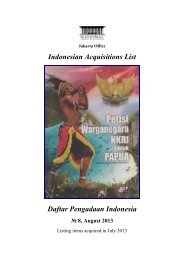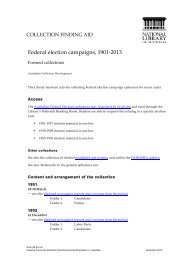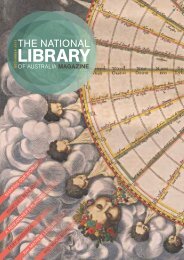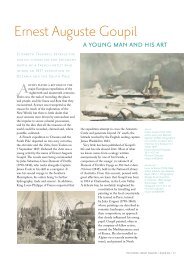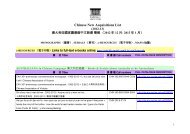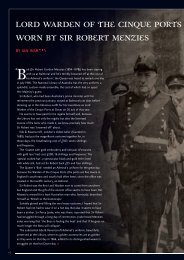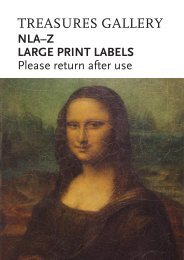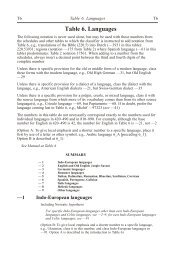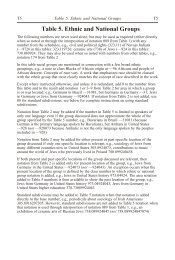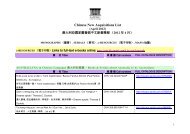An important vellum manuscript chart of the Dutch East India Company
An important vellum manuscript chart of the Dutch East India Company
An important vellum manuscript chart of the Dutch East India Company
Create successful ePaper yourself
Turn your PDF publications into a flip-book with our unique Google optimized e-Paper software.
The fact that not all ships followed <strong>the</strong> prescribed sailing instructions, is demonstrated by <strong>the</strong><br />
1726 disaster <strong>of</strong> <strong>the</strong> Ravensteyn. Against <strong>Company</strong> regulations, this Zeeland Chamber ship<br />
sailed along <strong>the</strong> west side <strong>of</strong> <strong>the</strong> Maldives and ran aground on an outer reef <strong>of</strong> <strong>the</strong> Ari-atol.<br />
This catastrophe is mentioned on our <strong>chart</strong>: Ravensteyn gebleven (Ravensteyn lost here). This<br />
reference is only present on our <strong>chart</strong> – as is <strong>the</strong> case with <strong>the</strong> loss <strong>of</strong> <strong>the</strong> Zeewijck. Being <strong>chart</strong>maker<br />
<strong>of</strong> <strong>the</strong> Zeeland Chamber, Abraham <strong>An</strong>ias gave full attention to this Zeeland calamity, as a<br />
matter <strong>of</strong> fact he even drew a detailed <strong>chart</strong> <strong>of</strong> <strong>the</strong> Ari-atol in 1728 (see ill.2).<br />
The wide-spread trading network <strong>of</strong> <strong>the</strong> VOC also stretched into <strong>the</strong> northwestern corner <strong>of</strong><br />
<strong>the</strong> <strong>India</strong>n Ocean, where <strong>the</strong> <strong>Company</strong> had trading-posts in Suratte, in <strong>the</strong> Persian Gulf and in<br />
Mocha. From Suratte <strong>the</strong> VOC ships sailed via Strait Hormus to Gamron in <strong>the</strong> north <strong>of</strong> <strong>the</strong><br />
Persian Gulf and to Basra on <strong>the</strong> Shatt-al-Arab. The sou<strong>the</strong>rn part shows <strong>the</strong> ‘Isola de Barein’<br />
(Bahrain). While <strong>the</strong> Gulf was significant for <strong>the</strong> silk trade, later <strong>the</strong> trade in gold was more<br />
<strong>important</strong>.<br />
Literature:<br />
Destombes, M., Cartes Hollandaises. La Cartographie de la Compagnie des Indes<br />
Orientales, 1593-1743. Saigon 1941.<br />
De VOC in de kaart gekeken. Cartografie en navigatie van de Verenigde Oostindische<br />
Compagnie, 1602-1799. ’s-Gravenhage, SDU uitgeverij, 1988.<br />
Gaastra, F. De geschiedenis van de VOC. Zutphen: Walburg Pers, 2002.<br />
Paesi, R. Het VOC-retourschip Ravesteyn, Nijmegen, 1999.<br />
Schilder, G.,‘Organization and Evolution <strong>of</strong> <strong>the</strong> <strong>Dutch</strong> <strong>East</strong> <strong>India</strong> <strong>Company</strong>’s Hydrographic<br />
Office in <strong>the</strong> Seventeenth Century’. In: Imago Mundi 28 (1976).<br />
Sigmond, J.P., Zuiderbaan, L.H., <strong>Dutch</strong> Discoveries <strong>of</strong> Australia, 1979, Australia.



